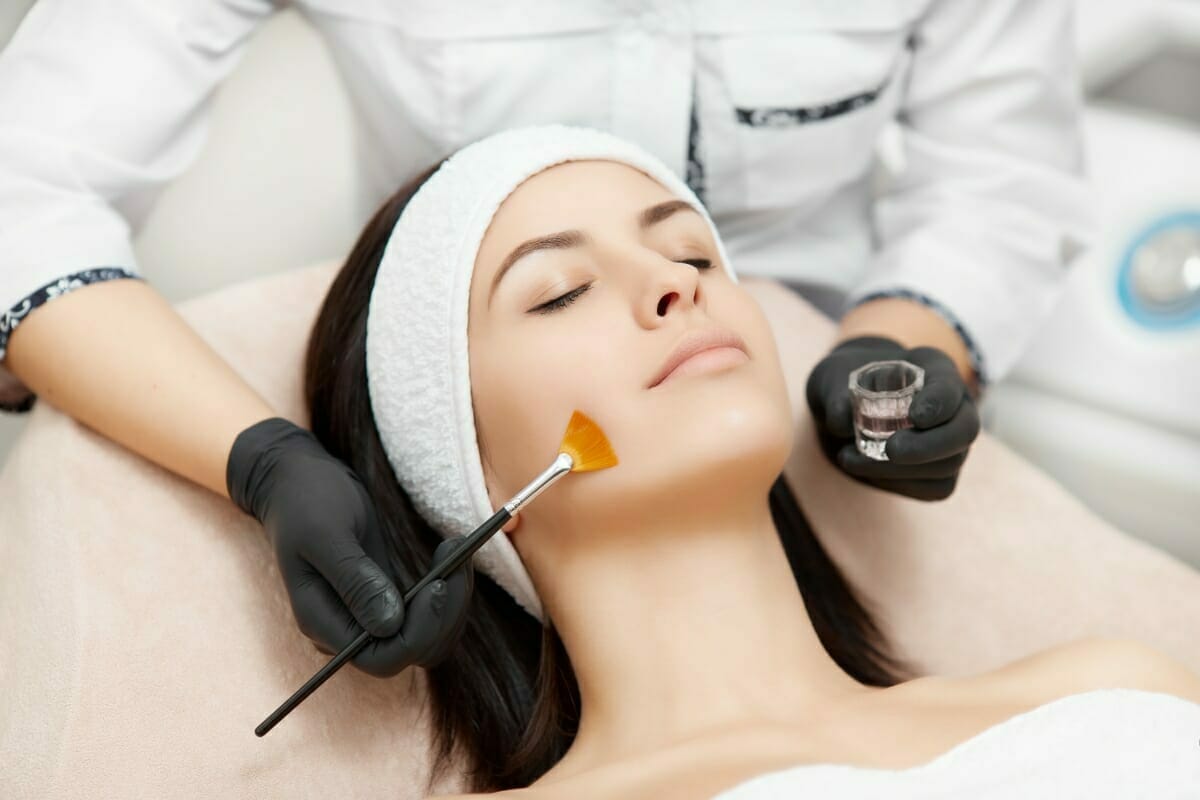During a medical peel, the uppermost layers of the epidermis are gently removed using various fruit acid mixtures, salicylic acid, TCA, or retinol. New cells reach the surface. The result is a fresher and more youthful appearance and a significant refinement of the skin surface.
Through the gentle removal of dead skin cells, one achieves:
- Reduction of fine lines and wrinkles
- Improvement of pigmentation disorders
- A more even skin tone
- Refinement of pores
- Positive effects on acne, acne scars, and skin impurities
- Long-term activation of collagen production
The applied mixture is individually tailored to your skin condition and needs to achieve optimal results.
Important Facts
- Treatment duration: 15-30 minutes
- Anesthesia: none
- Aftercare: no sun exposure, sun protection
- Result: The result is immediately visible. For long-term results, several treatments at intervals of 2-4 weeks are recommended.
- Pain level: none
- Social downtime: immediate
- Price: starting at €150
Different Types of Peels
Fruit Acid and Salicylic Acid Peels (AHA and BHA Peeling)

Fruit acids are the all-rounders among peels. With acid concentrations and exposure times specially tailored to your skin needs, it is possible to improve skin structure and stimulate collagen synthesis or minimize skin impurities as desired. You get an even skin tone and finer-pored skin. Improvement can also be achieved with pigmentation disorders using fruit acid peels.
The advantage of these substances is their high flexibility in application, which allows the peel to be optimally adapted to the patient’s skin type and condition.
It is recommended to combine the fruit acid peel cycle with appropriate home care to maximize the result.
A salicylic acid peel is particularly recommended for skin prone to impurities and acne. Since salicylic acid is fat-soluble, it can penetrate pores particularly well and dissolve impurities there. Additionally, it has an antibacterial effect that mitigates accompanying inflammations.
Pre-Party Peel - PQAge – Gentle and Strong with Immediate Lifting Effect
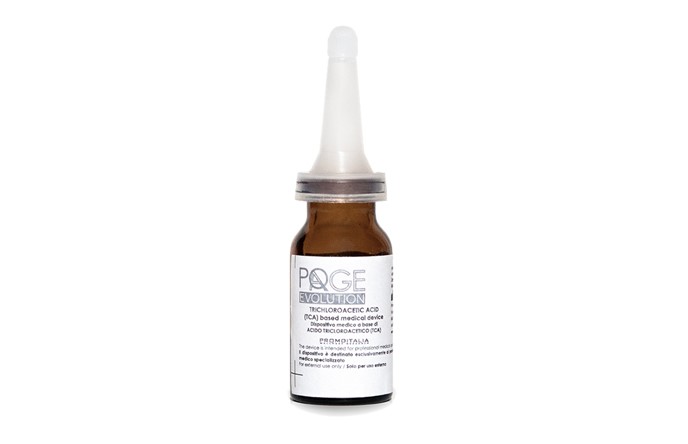
This particularly innovative peel enables gentle stimulation of the deep skin layers through trichloroacetic acid (TCA). The unique composition of the gel brings the active ingredients directly into the dermis, where they destroy old collagen fibers and stimulate fibroblasts (the skin cells responsible for collagen production) to form new fibers, but without the strong skin peeling usually associated with TCA. This results in sustainable skin renewal with increased skin elasticity.
The result is an immediate tightening of the tissue and regeneration and revitalization of the skin.
The novel mixture of stabilized trichloroacetic acid, kojic acid, mandelic acid, the specially developed Glyne complex (a natural multi-peptide), and the biostimulating coenzyme Q10 causes revitalization in the skin tissue without irritation, deep-acting lightening of pigmentation disorders, and stimulation of the body’s own collagen and elastin production as well as hyaluronic acid formation.
Results are visible after the first treatment. PQAge is safe and effective and requires no special precautions. For a long-term effect, 4-6 cycles at 14-day intervals are recommended.
Advantages of a Medical Peel
- Visibly younger-looking skin after the first treatment
- More glow
- Improvement of skin texture without irritation
- Applicable in any season
- Suitable for all phototypes
Retinol Peel
This peel is particularly suitable for treating unwanted pigment spots. Additionally, it has a very good effect on fine lines and wrinkles.
The highly effective peel is applied in the practice. The treatment is completely uncomplicated and takes only a few minutes. At home, you wash off the product after 3-8 hours, depending on your skin type, with a special cleansing lotion. The visual effect only sets in after 2-3 days.
Due to the high concentration of retinol, there is now a significant peeling of the skin, which lasts about a week. This effect is quite desirable as it contributes to strong regeneration and smoothing.
During this time, it is absolutely necessary to moisturize the skin with a specially developed care product to minimize dryness and sensitivity, and additionally to provide good protection from the sun.
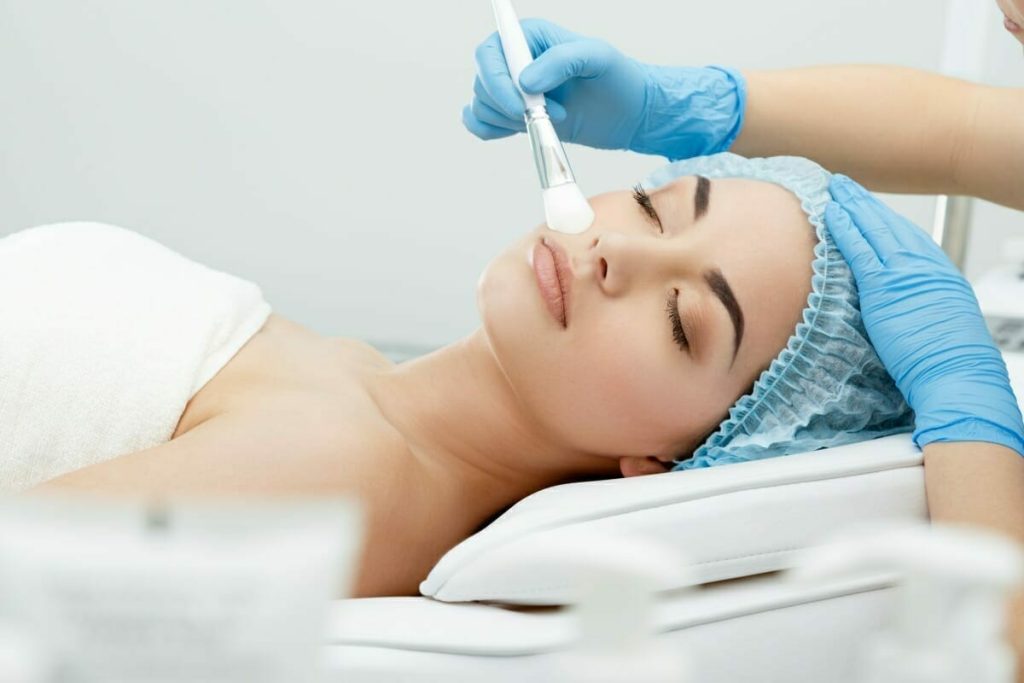
Frequently Asked Questions about Chemical Peels (FAQ)
What should you consider after a peeling treatment?
Immediately after the peel, you can go about your normal daily routine. However, sensitive individuals may experience skin redness, especially after peels with fruit acid mixtures. After a few days, there will be a (desired) exfoliation of the top layer of skin, so you should be sure to use consistent sun protection.
Tanning beds or sunbathing are strictly forbidden, otherwise you risk hyperpigmentation of the still fresh and unprotected skin.
You should avoid care products that can irritate the skin, such as fruit acids or retinol, until the skin has calmed down again. Swimming in chlorinated water is also not recommended with freshly peeled skin.
Under no circumstances should you try to remove the top layer of skin faster at home using mechanical devices such as cleansing brushes or peeling gloves after peels.
How many treatments are necessary?
A peeling cycle consists of several treatments spaced 2-4 weeks apart. In combination with appropriate home care, you will achieve a significant improvement in your skin’s appearance and a noticeably fresher and more radiant look. Many patients do a peeling cycle with 3-4 treatments in autumn and spring. On one hand, to reduce any sun damage and pigment spots after the summer, and on the other hand, to eliminate the effects of dry heating air, which in combination with the cold outside has left a pale complexion after winter.
Can I go about my usual activities after the peel?
In principle, you are not physically impaired after a peel and can go about normal daily activities (office work, housework). However, keep in mind that depending on sensitivity, the skin may also be significantly reddened, or that flaking may occur in the days following the peel. Therefore, I advise against having peels done just a few days before special events.
I want to look particularly great for a specific occasion, how far in advance should I have a peel done?
Depending on the type of peel, you’re on the safe side with seven to ten days, because by this time the skin’s peeling process is complete and you can enjoy your new radiant, fresh skin.
An exception is the Pre-Party Peel. Here, there is less peeling, and the effect takes place more in the deep layers of the skin, so that it can be done even a few days before an important event.
If it’s a very special event, such as your own wedding, I recommend doing a trial peel about six weeks beforehand, so that we can find out together exactly how your skin reacts to peeling substances, how long it takes to regenerate, and then plan the treatment accordingly before the big event. After all, you want to look as great as possible on such a special day.
What if I suffer from cold sores (herpes)?
Herpes viruses have the unpleasant property of remaining in the body for life after an initial infection and appearing as a new cold sore whenever the organism is weakened. Just as any sunburn or cold can represent a stress stimulus for the skin and thus be able to activate an existing herpes infection, chemical peels can have the same effect. People who suffer from frequent herpes infections on the face can also get a cold sore from medical peels. However, it is not the case that the method itself causes a herpes infection.
If there is an acute herpes infection (visible blister), chemical peels must be postponed as there is a risk of spreading the herpes viruses.
For whom are chemical peels not suitable?
There are people who should not undergo chemical peels because, although rare, they can also be associated with risks:
-
Pregnant women
-
Patients undergoing therapy with vitamin A analogues (Ciscutan, Roaccutan) for severe acne.
-
After laser treatments of the skin
-
Those with a tendency for impaired wound healing
-
After wax hair removal
-
In case of known allergies to the ingredients
-
If intense sun exposure is expected in the coming weeks (planned beach vacation, etc.)
Which type of peeling for which skin?
The different types of peeling substances differ in their depth of penetration and their effect. While retinol, for example, is particularly good for treating pigmentation spots, salicylic acid is excellent for combating skin impurities. The Pre-Party Peeling gives you an immediate effect without any downtime and a very strong collagen stimulation, which counteracts skin aging with regular use. Fruit acid peelings are absolute all-rounders suitable for every skin type, however, it’s important to adjust the acid concentration to your skin to achieve the optimal effect. Selecting the most suitable peeling for you requires a detailed consultation.
How does a medical peeling differ from a treatment at home or in a beauty salon?
The peelings available in stores are usually so-called mechanical peelings. Here, the uppermost skin flakes are rubbed off with the help of tiny particles (unfortunately often including the controversial microplastics!) like with sandpaper. You won’t achieve an effect on the deeper layers of skin with this. However, the mechanical irritation can lead to redness in sensitive skin types. The chemical peelings offered in beauty salons work with acid, but the pH value used is not as low (the substance is not as acidic) as with a medical peeling in a doctor’s office. For this reason, the effect is also weaker than with a medical peeling.
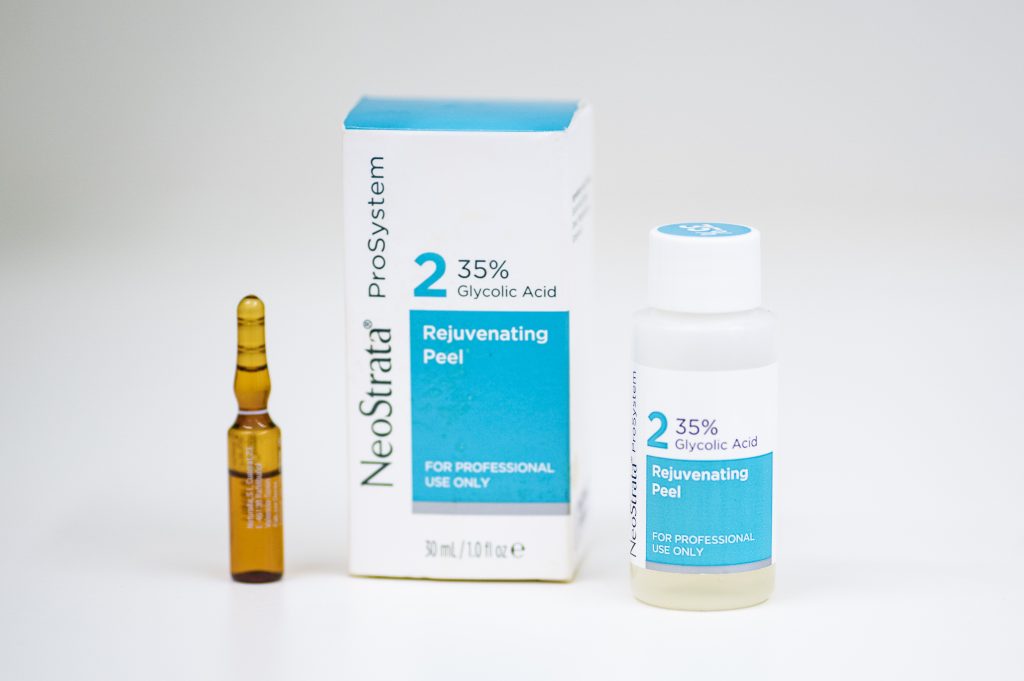
Can you only peel the face?
No, depending on your wishes, the treatment method can also be used on the neck, décolleté, hands (for age spots) or back (especially for acne).
What aftercare is necessary following chemical peelings?
The aftercare is carried out by the patients themselves at home. It consists of applying mild care products, which you receive at the practice for home use, and consistent sun protection. Under no circumstances should you pluck at the flakes that are coming off the skin or try to forcibly pull them off.
If sun protection measures are not followed (both generally avoiding the sun and always consistently applying sun care with a high sun protection factor in the UVA and UVB range), there is a risk of hyperpigmentation. Therefore, it is absolutely necessary that you follow the instructions for aftercare at home.
Do chemical peelings hurt?
During the exposure time of the various acids, there may be a more or less intense burning or tightening sensation of the skin, depending on skin sensitivity and acid concentration. The skin may be reddened and feel hot. However, this feeling usually subsides in the first hours after treatment. A few days later, when the skin’s peeling process begins, the feeling is comparable to a mild sunburn. The skin feels very dry and tight. After each treatment, you will receive the appropriate care products for use at home to optimally care for your skin during this time.
How does the peeling treatment proceed?
After a consultation, the skin surface is thoroughly cleansed and degreased with special substances. Sensitive areas such as the lips or the skin around the eyes are protected with a fatty ointment. Subsequently, the peeling substance is applied in several layers. This is then neutralized after an individual exposure time tailored to your skin type. Afterwards, the skin is treated with appropriate care substances.
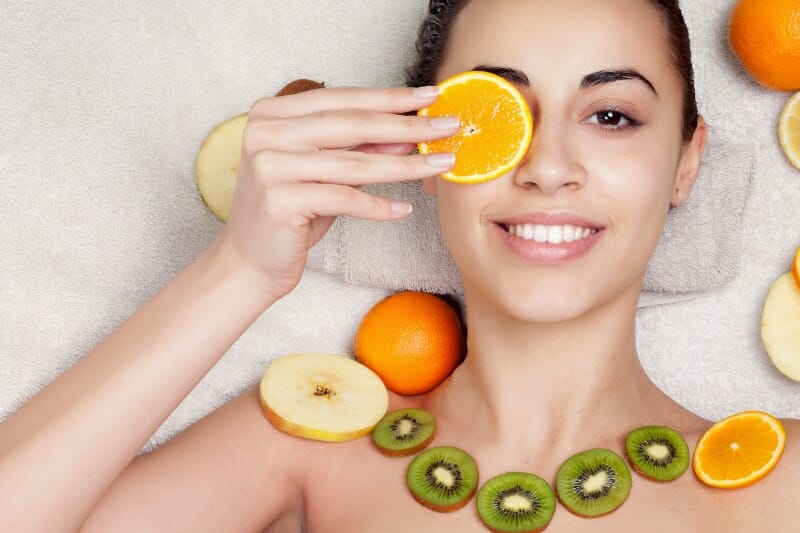
How long does the peeling treatment take?
Plan for about half an hour of treatment time for your chemical peeling.
How can I further optimize the results of my peeling?
By using additionally adapted care between individual peeling treatments and afterwards, it is possible to further improve the results and maintain the skin’s renewal process and stimulation of collagen synthesis.
